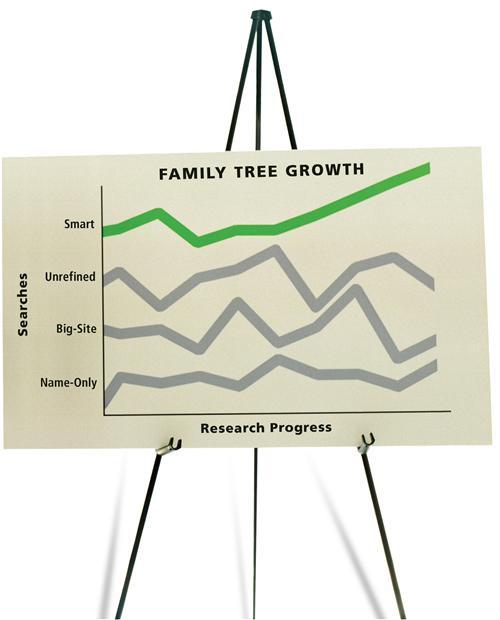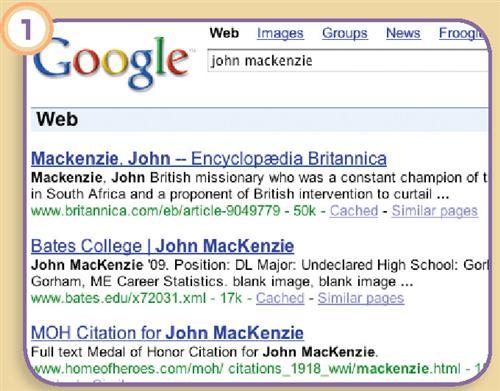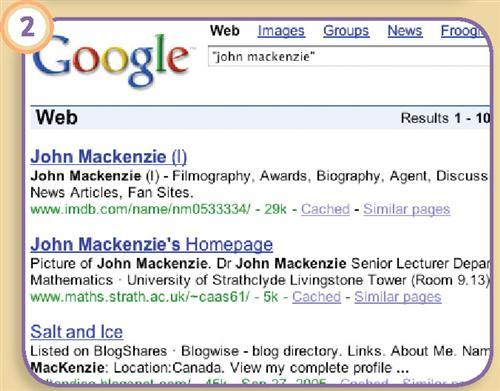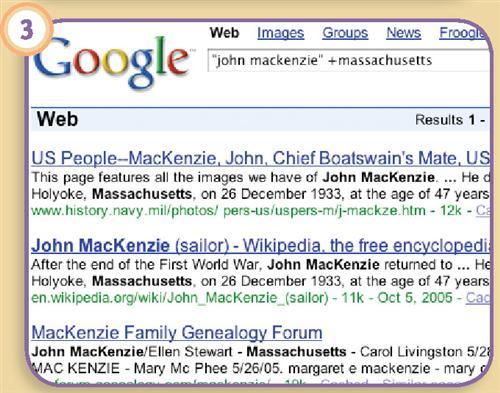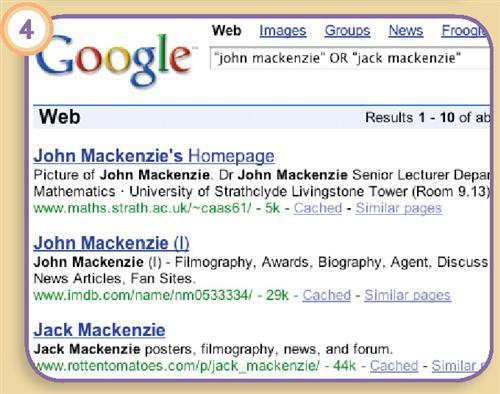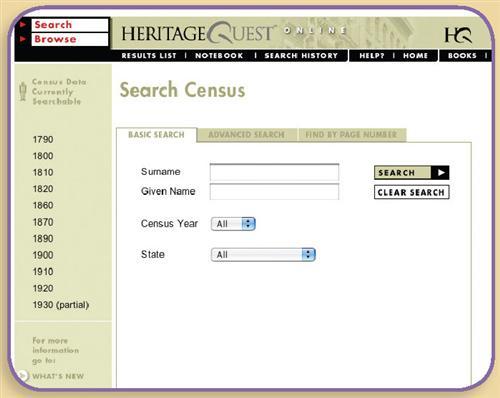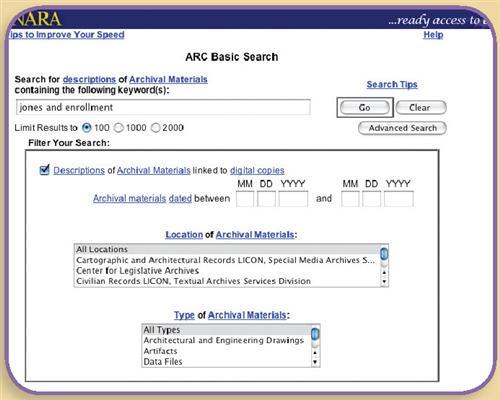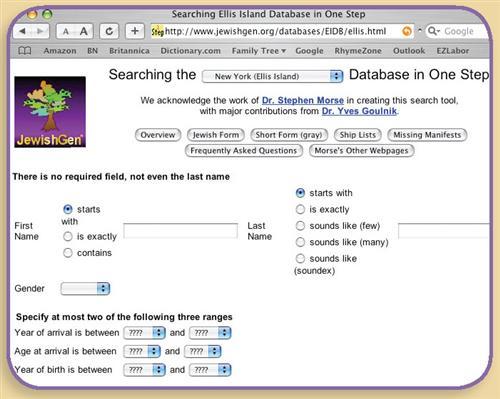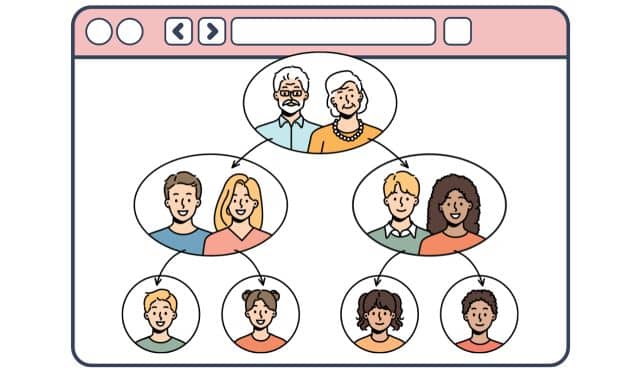Sign up for the Family Tree Newsletter Plus, you’ll receive our 10 Essential Genealogy Research Forms PDF as a special thank you!
Get Your Free Genealogy Forms
"*" indicates required fields
I love a challenge, especially when it comes to finding ancestors on the Internet. Give me a name, date and place, and I’m off to the races. Hours fly by unnoticed, dinner goes uncooked and vacuuming is far from my consciousness. Nothing exists but the puzzle.
If you’ve given up “real” online research in favor of quick searches, you’re missing the best part of Internet genealogy: the fun of focusing your detective skills and the Net’s limitless resources to turn a tangle of clues into a tidy solution.
By researching online, I’ve wrestled some of my toughest problems to the ground. I’ve found distant cousins, regenerated dead-end branches and added hundreds of names, dates and places to the blanks in my family tree. You can, too, if you try these tricks for smarter searches.
1. Master search-engine math.
At some point, every Internet genealogist has used a search engine and gotten thousands of irrelevant results. That’s because search engines are like trained puppies-they fetch whatever you throw them. For instance, if you type john mackenzie into a search engine, it will find every page containing the words john and mackenzie, but not necessarily in that order. That means you’ll get results such as John Thompson who works at the Mackenzie Institute, or Mackenzie Brown, teammate of Gordon John. Would you rather wade through all those irrelevant pages or refine your search to bring back the best bones? Search-engine math to the rescue!
Most search engines use operators to help refine searches. The most-common operators are quotation marks (“”), the plus sign (+) and the minus sign (−). Here’s how each operator works.
? Quotation marks: Use quotation marks when you want to find an exact phrase. In the example above, if we had searched for “john mackenzie,” the search engine would have looked for instances in which the words john and mackenzie appeared side by side and in that order. When I typed john mackenzie into Google <www.google.com>, the popular search engine returned 5.8 million hits. But when I searched for “john mackenzie,” I got only 165,000. That’s still a lot, but don’t worry-we’ll refine our search even more.
? Plus sign: Use the plus sign (or the word and) when you want the search engine to look for multiple words or terms. Let’s pretend you’re trying to locate John Mackenzie records relevant to his life in Massachusetts. Your search would look like this: “john mackenzie” +massachusetts or “john mackenzie” +ma or “john mackenzie” and massachusetts. (Be sure to try more searches using variant spellings or abbreviations.) The plus sign or word and tells the search engine to return only the matches for “john mackenzie” that also include massachusetts, weeding out all the others.
? Minus sign: The minus sign tells a search engine to exclude a specific word. If your search for “john mackenzie” returned hundreds of John Mackenzies who lived in Maine, and you want only those who lived in Massachusetts, here’s how you’d construct the search: “john mackenzie” +massachusetts-maine. (Have you noticed that I never capitalize my search phrases? It’s because search engines aren’t case-sensitive, so I save myself the trouble of reaching for the Shift key.)
Two more helpful operators are or and near. Use or when either of two words is appropriate, and you want the search engine to find all instances where either word appears. For example, you might use this operator if John Mackenzie’s nickname was Jack. By typing “john mackenzie” or “jack mackenzie” into the search engine, you’ll find any pages that include either his given name or his nickname. (Of course, this operator might give you more search results rather than fewer. Note that Google requires the or operator to be in caps.)
Although it doesn’t work with all search engines (including Google and Yahoo! <www.yahoo.com>), near is another helpful operator. Near tells the search engine that your search terms must be in proximity to one another (usually within 10 words). When would you use near? If John Mackenzie’s middle name was Albert and you searched for “john mackenzie,” the search engine wouldn’t return pages with the name John Albert Mackenzie. To make sure that the engine returns all pages with his full name, too, you could search for john near mackenzie.
Check the Advanced Search or Help section of your favorite search engine to learn more about the operators it uses. That way, you’ll get fewer irrelevant hits the next time you search.
If you think the Internet’s good only for finding general information, you haven’t put search-engine math to the test. Several years ago, it was difficult to find genealogical records online because they just weren’t there-few people had taken the time to transcribe and upload census, land or vital records. Fortunately, that’s changed: New transcriptions (as well as digital document images) are hitting the Web daily. And if a record’s on the Web, you can find it-with a couple of exceptions.
If a webmaster doesn’t want anyone to find a specific page (or pages), he can include a line of text in a special file that tells search-engine robots to exclude that page from any list of results. Why would someone want to hide a page? The page may include personal information, such as addresses or phone numbers, that the webmaster wants to share only with family members. Another possibility: A page is so new the search engine “spiders” haven’t found it yet (a spider is a program that indexes Web pages). But you still can find most Web pages by using the right combination of search terms. So grab your genealogy to-do list, and let’s start searching.
On my to-do list, I noted that I’d like to learn more about my ancestor Galen Cave’s marriage. I didn’t know where he wed, but he died in Missouri, so I decided to start there. Here’s how I constructed my first search: “galen cave” +missouri +marriage.
That query turned up one hit-a reference to an online transcription of North Carolina marriages to 1850. I went to that Web page and found my man, plus an unexpected bonus: The researcher had posted the Web address (URL) of the entire transcription, so not only did I get information about Galen’s marriage to Susannah Easley, I also found data on five other Cave marriages.
See how easy Internet searching can be? I decided to try one more: a census transcription with Galen Cave’s name. Because he was married in North Carolina, not Missouri, I revised my search by omitting any Missouri references: “galen cave” +census + “north Carolina” -missouri.
Oops. That search turned up zero results. Next, I crafted the same search to turn up pages with references to Missouri. Why? Because I thought there might be a Web page that referenced Cave in both North Carolina and Missouri. I was right. Google found a site that detailed Cave’s Missouri life and mentioned him on a Surry County, NC, census, but under the name Galion. Another bonus: This Web page had a link to a photo of Cave’s tombstone.
Remember, of course, that the more refined your search, the fewer search results you’ll get-so if the search engine returns zero hits, remove a search parameter and try again.
3. Scout out smaller sites.
Dollars to doughnuts you’ve searched for ancestors at well-known sites such as FamilySearch <www.familysearch.org> and Ellis Island <www.ellisisland.org>. But have you ever thrown a dragnet over resources such as the Ohio Death Certificate Index<www.ohiohistory.org/dindex>, The Handbook of Texas Online <www.tsha.utexas.edu/handbook/online>, or Clay County, Tennessee, Marriages 1871 to 1880 <www.public.asu.edu/~moore/claymarriage>? Probably not.
Although lesser-known, thousands more resources just like these are sitting on low-profile Internet sites-ones you might never have known about or looked for. Some of the sites have free databases; others contain transcriptions of county histories and Bible, vital and military records. All are potential additions to your bag of online tricks.
To track down these sites, become an expert in a state’s online resources. That means your first searches won’t be for ancestors, but rather for Web sites related to the places your ancestors lived. First, decide on the state where you’ll be doing the majority of your research. Then, visit these five sites and begin compiling a list of the Web destinations you think might contain information about your family.
? Cyndi’s List <www.cyndislist.com>: Down toward the bottom of Cyndi’s home page is a category called States, Regions & Localities Within the States. Follow links from your state to hundreds of resources, including free databases.
? Genealogy Resources on the Internet
<www.rootsweb.com/~jfuller/internet.html>: Look for your state in John Fuller and Chris Gaunt’s alphabetical listing of Web sites, mailing lists and more.
? GeneaSearch <geneasearch.com>: Scroll down to States Genealogy. Each state page contains links to state-specific databases, maps and historical information.
? United States Links <www.rootsweb.com/roots-l>: Select a state name on the left side of the page for details on genealogical and historical resources.
? USGenWeb <www.usgenweb.org>: To get to the state-specific resources, select a state name from the left frame or click on the States link for a clickable US map. Then click on the individual county links for local genealogies.
Next, go to your favorite search engine and add more sites to your list by typing in phrases like these:
? “iowa genealogical resources”
? “iowa genealogy”
? “iowa marriages” “iowa census”
? “iowa wills”
? “iowa genealogy database”
? “iowa vital records”
? iowa +“civil war” +records
? iowa +“civil war” +rosters
? iowa +“state archives”
Use this same technique to locate data-rich sites for specific events your ancestors experienced, such as the Civil War, War of 1812, Homestead Act or immigration.
Keep track of the sites you visit so you can go back to them in three to six months and search again. Webmasters often upload new information; just because you didn’t find an answer the first time around doesn’t mean it won’t be there the next time. (For more lesser-known and state-specific sites, see the August 2005 and December 2005 issues of Family Tree Magazine.)
4. Look for places, not people.
Even though New York City’s 1850 population surpassed the half-million mark (according to the US census), most American towns and villages remained small. That year, fewer than 10,000 people called Lexington, Ky., or Concord, NH, home, and only 200 Americans lived in Niles, Ill. With so few people living in any one location, it often pays to search for a place, not a person. Why? Place searches will frequently return pages about your ancestors, their neighbors, their parents or their in-laws.
This technique will work whether you use your favorite search engine or a genealogy database such as RootsWeb WorldConnect <worldconnect.rootsweb.com> or GenCircles’ Global Tree <www.gencircles.com/globaltree/search>.
For instance, when I typed niles illinois into WorldConnect’s Death Place search box, I got 633 hits; on GenCircles, I got 83. Too many to wade through? Not really. If you click on your ancestors’ names (or their in-laws’) in the list of search results, you’ll discover who else is researching your family. And as you probably know, networking with other researchers can be the fastest way to break down brick walls.
Not only can searching for a place help you find others researching your family, it also can lead you to town or county histories that mention early families or pioneers. To find those resources, construct searches similar to these:
? shelbyville +indiana +history
? “san diego” +“county history”
? libertyville +missouri +genealogy
? “johnson city” +tennessee +pioneer
And be sure to perform extra searches substituting state abbreviations for the full spellings (such as “johnson city” and tn, “johnson city” +tn or “johnson city” and tenn), just in case the online record uses the short form.
A great place to try this search strategy is USGenWeb. As noted earlier, this site is organized by state and then by county. County pages can hold a wealth of resources, including biographies, maps and transcriptions of cemetery, military and marriage records. Once you surf to your ancestor’s county, search for his surname as well as the in-laws’ surname.
Some USGenWeb sites, such as the one for Lincoln County, Kan. <skyways.lib.ks.us/genweb/lincoln>, even have their own search engines, which makes looking for numerous surnames much easier. A search for hendrickson on the site returned 89 hits-almost all relevant to my family.
State-specific message boards also can yield results, particularly if you’re not sure of the county or town in which your family lived. You’ll find searchable state boards at GenForum <genforum.com> and Ancestry.com <boards.ancestry.com>.
What’s great about Ancestry.com’s message boards is you can perform a global search across all the site’s boards. This trick can help ferret out ancestors who may have been born in one place, married in another and died in a third. For example, a global search for shelbyville indiana returned more than 2,000 hits, with some of the results showing up on surname boards, as well as state boards for Indiana, Kentucky, California and Kansas.
5. Try multiple databases.
Do you have a favorite search engine or genealogy Web site that you use 99 percent of the time? Most of us do. But you’ll have the highest degree of success when you learn to move back and forth between databases or search engines as you uncover clues.
Not all search engines are created equal. Each one uses its own secret algorithm to determine the relevance of Web sites during a search, so the results will vary from search engine to search engine. For example, using AltaVista <www.altavista.com>, the search phrase “johnson city” +tennessee +genealogy returned 971 hits, Google grabbed 4,210 and AlltheWeb <www.alltheweb.com> returned 11,021. Are one search engine’s results more relevant than another’s? That’s for you to decide.
When I queried AltaVista with “alice chapman” +orange +NC, I got a link to a Web site stating that Orange County is where Alice was married, not born. As a bonus, one of the hits was a Web site with detailed research on her husband’s family. The same search performed on Mamma <www.mamma.com> returned 27 hits, none of them helpful. When I sent the metasearcher Dogpile <www.dogpile.com> out to fetch, the most relevant results came back from Google.
When you’re searching genealogy databases, it’s important to remember that many Web-posted records don’t reference sources and haven’t been checked for accuracy. For instance, no one has verified the information in FamilySearch’s popular Ancestral File database. As a result, if an Ancestral File record says your ancestor was born in 1811 in Princeton, NJ, and a WorldConnect file says the date of birth was 1814, you can’t believe either date unless there’s a source. Even then, it’s best to see the original record yourself.
You’ll often find conflicting data in your research. For instance, when I searched genealogy databases for my ancestor Alice Chapman, her birth was cited variously as unknown date, Orange County, NC; 1760, Bucks County, Pa.; and 1764, Knoxville, Tenn. I don’t know which information is correct, but I do know at least three places to begin my search.
Use as many general search engines or genealogy-specific databases as possible. Don’t forget to note where you found each piece of information-and not just to document your own discoveries. If you later search original records and find discrepancies, contact the webmaster, so she can post the correct data.
6. Go beyond genealogy sites.
Because FamilySearch and WorldConnect databases are so big, it’s tempting to search just those sites. But plenty of Web sites that aren’t genealogy-specific still might hold clues about your ancestors.
For example, if you have an unusual surname, go to the US Geological Survey’s Geographic Names Information System (GNIS) Web site <geonames.usgs.gov/pls/gnispublic>, click on US and Territories (under Query GNIS) and type the name into the Feature Name search box. I typed in the surname Hatton and got 76 places with that name, eight of them in Kentucky-the first known place my Hattons lived. Is it possible that one of these places was named for my family? I don’t know, but you can bet those eight places will go on my research list.
Next, I searched GNIS for my oddest surname, Faulkenberry. There were two places listed, both in Limestone County, Texas. I surfed over to The Handbook of Texas Online and discovered that Faulkenberry Creek was “probably named for David Faulkenberry, who settled in the area in 1835 as part of Sterling C. Robertson’s colony.” Now I have even more clues.
Of course, the next stop was Limestone County’s USGenWeb page <rootsweb.com/~txlimest>. There, I found still more information about David, including his wife’s name and his role in the Fort Parker massacre. Did I stop there? No way. I did even more research using webwide search engines, along with WorldConnect, GenCircles and FamilySearch.
Finally, I searched the Texas General Land Office’s Land Grant Database <glo.state.tx.us/archives/landgrant.html>, where I learned that David had title to 4,428.4 acres. Five dollars got me a copy of the land records. By the time I’d finished my search, I had pages of information about a branch of the family I’d known nothing about. Here’s where knowing about those various Texas resources really paid off.
What do you do if your family comprises all Smiths and Joneses? Searching for common names can be difficult, but it’s not impossible. When using a search engine, refine your query as much as possible, adding terms such as place, date, event or even in-laws’ names. If you’re using genealogy databases, be sure to look for variant spellings, and search for events in which your ancestors may have participated. For example, if you have a male ancestor born in the 1830s, look for him on Civil War rosters and pension files. Or look for his wife’s maiden name in a marriage record.
If your Smith or Jones family settled early on in a county, seek out county histories and lists of pioneer names. Or use a search engine to look for biographies; they might not mention your ancestor, but you may find a neighbor, in-law or allied family (a family who migrated with yours). One of my cousins discovered significant clues about our third-great-grandfather in the biography written about his brother.
Taking Stock of Records
With so many institutions and individuals transcribing their genealogical documents, you can find real records on the Net. If you’re not sure which records are available, think about the paper trails you’ve created. Then make a list of the records your ancestors might have generated, such as the examples below. These document types can serve as keywords for your searches.
? bank records
? baptismal certificates
? birth certificates
? court records
? driver’s licenses
? family Bibles
? funeral-home records
? high school or college diplomas
? insurance claims
? land records
? marriage records
? membership cards
? military records
? newspaper articles
? pension files
? probate files
? Social Security applications
? wills
Boolean For Beginners
Getting thousands of irrelevant hits? Here’s a quick lesson in search-engine math.
1. First, choose a search engine, such as Google <www.google.com>, and search on just your ancestor’s name (for example, john mackenzie). The search engine will find any page with the words john and mackenzie. In this case, Google found about 5.8 million pages-way too many to wade through.
2. Next, try putting quotation marks around your ancestor’s name: “john mackenzie.” This time, Google turns up 165,000 pages in which the words john and mackenzie appear side by side.
3. Now add a search term that’s relevant to your ancestor’s life, such as the state where he lived: “john mackenzie” and massachusetts or “john mackenzie” +massachusetts. The plus sign (+) or word and tells the search engine to return only the matches for “john mackenzie” that also include massachusetts. That’s 510 pages, a much more manageable number than 5.8 million.
Narrow your search even further by using the minus sign, which tells the search engine to exclude a specific word. Let’s say you want to exclude all pages that refer to Maine. Using our example, you’d type “john mackenzie” +massachusetts – maine into the search engine. Voila! Only 234 hits.
Popular Mechanics
With familiar family history cyberstops constantly tweaking their search tools, it’s tough to keep tabs on what’s where-and how to find the data on your ancestors. So we compiled this cheat sheet for seven of our favorite free genealogy Web sites. Clip it out, post it next to your computer and give your online research a boost.
1 Cyndi’s List
Key Content:
? 245,000-plus links to genealogy Web sites
Hints:
? You can search the entire site fastest using Yahoo! or Google. Type a keyword plus site: cyndislist.com.
? When you’re cruising Cyndi’s category pages, don’t scroll through the whole category if you’re looking for a specific word or phrase. Instead, use your browser’s Find function (Edit Find; or for a shortcut, hit control-F in Windows or command-F on a Mac) to locate your keyword instantly.
? Sites submitted in the past two years don’t appear on the category pages (they haven’t yet been classified). Use a search engine or Cyndi’s global search to find relevant sites, or go to Browse the New Links, where you can drill down through listings for specific months.
2. FamilySearch
Key Content:
? International Genealogical Index (IGI) to millions of birth and marriage record extracts
? Ancestral File and Pedigree Resource File of researcher-submitted family trees
? 1880 US census, 1881 British and Canadian censuses
? Social Security Death Index
? Vital Records Index for Mexico and Scandinavia
? Family History Library catalog and handy Research Helps
Hints:
? When you search for ancestors, you have to enter at least a last name. FamilySearch ignores middle names unless you check the Use Exact Spelling option-but you can’t specify the parents, spouse, event, year or country with that option.
? Once you find an ancestor in the IGI, click on the batch number (under Source Information) and do a new search to find all other births or marriages entered at the same time-they might include relatives.
3. HeritageQuest Online
Key Content:
? images of all available US censuses, 1790 to 1930, with searchable head-of-household indexes to most years
? Revolutionary War pension and bounty-land warrants
? Periodical Source Index to articles in more than 6,000 genealogical and historical periodicals published in the United States and Canada
? 25,000-plus family and local history books
Hints:
? You can access this Web site only through subscribing institutions. Ask if your public library or genealogical society offers remote access-if so, you can log on from your home computer by entering your library-card or member number on the subscribing institution’s Web site.
? Click Browse in the upper-left corner of the main census page to access unindexed images.
? When you search for ancestors’ names, try spelling variations. You also can catch multiple spellings at once using wildcards. A question mark replaces one letter: Type mill?r to find Miller and Millar. Substitute an asterisk for multiple characters: Entering rand* would find Randall, Randell and Randolph.
? Save important searches in your “notebook” so you can call them up quickly later.
4. National Archives and Records Administration
Key Content:
? few digitized records
? Archival Research Catalog (ARC) of the archives’ paper materials; entries for many maps, photographs and American Indian records link to digital images
? Access to Archival Databases (AAD) system cataloging electronic materials, including WWII enlistment cards and Irish immigrants escaping the potato famine
? searchable database of microfilm publications
? online ordering system for reproductions of passenger lists, census pages, Eastern Cherokee Applications, military service records and land entry files
Hints:
? If you want to limit your ARC search to digitized documents or photos, check the box next to “Descriptions of Archival Materials linked to digital copies.”
? ARC uses Boolean searching, and doesn’t always like when you leave out operators such as and, or and not. If your search doesn’t work, try adding the appropriate Boolean term.
? By default, ARC limits your results to 100. To allow for more hits, select the 1,000 or 2,000 button.
? Don’t get confused by date ranges following AAD database titles-those indicate when the electronic file or database was created, not the years the data covers (look for coverage dates).
? These searches’ interfaces aren’t intuitive and can be finicky. For example, to find someone in the Dawes Rolls (an Indian census) using ARC, you need to type in the keyword enrollment, as in jones and enrollment. Be sure to read any search tips and FAQs before searching.
5. One-Step Webpages by Stephen P. Morse
Key Content:
? enhanced search forms for Ellis Island and Castle Garden immigration databases
? simultaneous searching of several Social Security Death Index Web sites, RootsWeb mailing lists and US phone books
? census enumeration-district locators and converters, street-name change lookup and microfilm-roll finder
Hints:
? These tools don’t let you “hack” into subscription Web sites for free-to access results for any paid databases, you need a subscription to that content.
? Use Morse’s one-step tools as a back door when you’re unsuccessful searching immigration, census and vital-records databases directly.
? When searching for Ellis Island arrivals, use the white form to search on the port of departure or multiple surname spellings simultaneously (select “sounds like”). Use the gray form to specify age at arrival or search for every passenger from a specific town. Use the blue form to find people identified as Jewish on the ship manifest.
6. RootsWeb
Key Content:
? archives of nearly 30,000 electronic mailing lists
? WorldConnect database of user-submitted family tree files (combined with Ancestry World Tree; 385 million total names)
? RootsWeb Surname List, a registry of people researching particular surnames
? Social Security Death Index, message boards, state resources
? hundreds of databases containing user-contributed record indexes, abstracts and transcriptions
Hints:
? Visit <searches.rootsweb.com> to locate relevant databases and search options.
? If you’ve submitted your family tree file to RootsWeb or Ancestry.com, you can exclude it from your search results: Enter your user code in the advanced search’s Skip Database field.
? Use Google to search specific resources-its advanced features can get around RootsWeb’s limitations. For example, you can simultaneously comb all of RootsWeb’s mailing lists at Google by including their Web domain (type your search term plus site: archiver.rootsweb.com). To search for other RootsWeb-hosted family Web sites, add site: freepages.genealogy.rootsweb.com.
7. USGenWeb
Key Content:
? pages for every US state and county (actual content varies)
? links, queries and databases of user-contributed information
? USGenWeb Archives projects of transcribed marriage records, military pensions, obituaries, church records and census images; plus transcribed inscriptions from the USGenWeb Tombstone Project
Hints:
? Visit USGenWeb pages for background on states and counties your research leads to.
? You can’t search for names on the census images-instead, browse the index files. You’ll find more browsable indexes at <www.us-census.org> and <www.rootsweb.com/~census>.
? Since the census indexes don’t link to images, use multiple browser windows to toggle between index files and their corresponding page images. (It’s still tedious, but keeps you from losing your place.)
? USGenWeb isn’t the only volunteer network for place-based genealogy. Try the American History and Genealogy Project <www.ahgp.org> and the American Local History Network <www.alhn.org>, too.
ADVERTISEMENT

